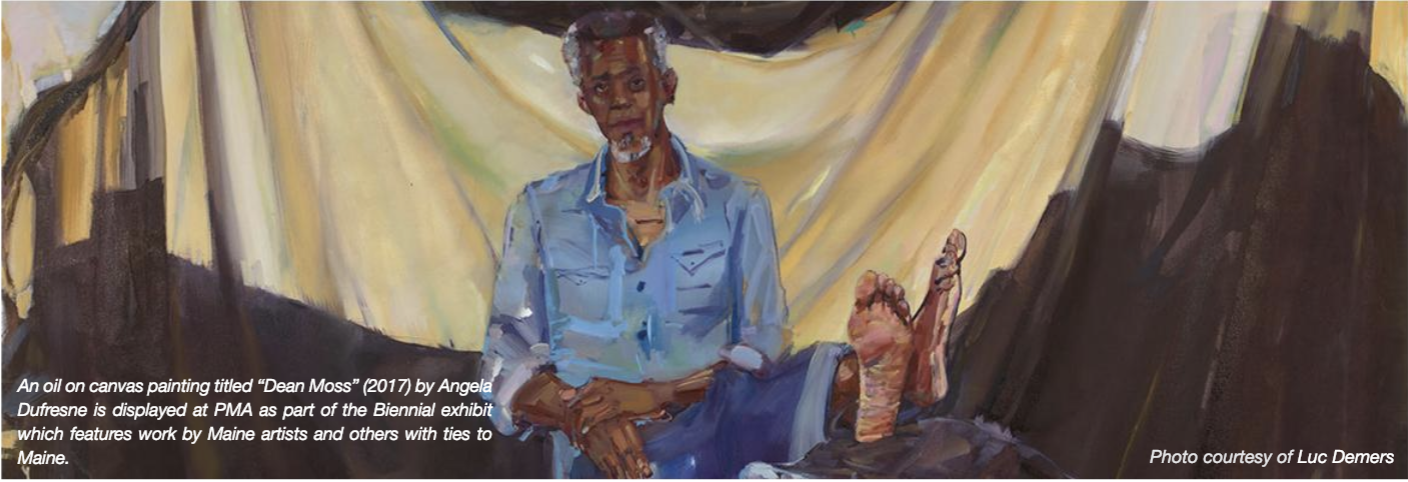Ben Theriault, Staff Writer
The Portland Museum of Art (PMA) has an eclectic array of art from all over the world. The museum boasts a collection housing 18,000 individual works, with artists featured such as Edward Hopper, Rene Magritte, Edvard Munch and Andy Warhol; PMA has a prestigious variety. Despite having countless pivotal pieces, PMA places great importance on having a rotation of fresh art and promoting up-and-coming artists. A terrific way to do this is through their biennial event.
The 10th PMA Biennial was opened last Friday, January 26 and will be on display until June 3. The compilation of work is a way to display the works of Maine-connected artists. This year there were about 60 individual pieces created by 25 artists. Nat May, the curator for the exhibit, wrote that the biennial is about showcasing the work of deserving artists as well as displaying Maine’s connection to the world.
The art featured comes in a plethora of forms ranging from photos to quilts and everything in between. Many pieces blend various art platforms together to create beautiful hybrids. For example, Daniel Minter’s work “A Distant Holla” combines sculpting, wood carving, and painting together to create an intricate layout. The piece is a large, meticulously carved slab of wood. Parts of this are carved into faces and painted, allowing some of his characters to become even more vivid. Paintings inspired by African spirituality are layered amongst the carvings, seemingly blending the two art forms together.
Many of the works displayed deal with weighty topics such as sexism, racism, and mental illness in contemporary society. Anne Buckwalter’s mural “The Republic of Hysteria” features a collection of women all dressed in hyena skins. The women are randomly dispersed throughout the piece in a way semblent of evolution. At the top of the mural the women almost appear neolithic, as they are around a basic fire with very basic tools.
As the mural descends towards the bottom the setting becomes more distinctly urban. There is a basic brick building coated with graffiti. Near the building women are surrounding multiple banners. One says “A believed story” and the other says “A shared burden.” This is perhaps a statement regarding sexual assault throughout humanity: the treatment of women in today’s society is not far from barbarism.
Buckwalter stated that the women were dressed in hyena skins as a way to reclaim the hyena as a symbol. She notes that hyenas have been historically demonized. Spotted hyenas maintain a matriarchal society—the women are frequently larger, more aggressive and more sexually promiscuous while the men are submissive. She believes that rather than condemning these traits, the hyena clad women should be celebrated.
Race is dealt with explicitly in two charcoal sets by Shaun Leonardo. The first set of two drawings, titled “Tamir Rice,” progressively depicts the murder of 12 year old Tamir Rice. As a companion piece, there is a set titled “Laquan Mcdonald,” which displays the killing of Laquan Mcdonald, a victim of police brutality in Chicago as in 2014. The scenes are drawn vaguely with blurred lines. The drawings serve as a testament to those who have lost their lives to police brutality and fall within his thematic cluster of art that confronts hypermasculinity. Leonardo has stated that he wishes to portray men as unfeasible caricatures of society’s expectations. Through these depictions he is able to illustrate ways men have internalized these expectations and in the case of the sketched police officers—the dire consequences that accompany that internalization.
Artist Becca Albee exercises minimalism in her physical analysis of the book Radical Feminist Therapy: Working in the Context of Violence. This piece is a compilation of notes she had taken while analyzing and critiquing the book. She condensed every page of notes taken into one letterhead to represent each chapter. The result is a series of 15 pieces of paper with inscrutable lines and scattered phrases. Albee was interested in capturing the process of active learning and wanted to find a way physical way to present this idea.
Other notable art consists of work by David Driskell, who creates African art through a combination of painting and collaging; Jonathan Mess, who constructs sculptures from shards of rock; Elise Ansel, who uses oil paints to create large works of abstract art; DM Witman, an artist who has compiled satellite images of geographical features and lastly Gina Adams, who created quilts articulating the negligence of Native American treaties.
Attendance at the PMA Biennial resulted in a full house; hardly any pieces were vacant. The Biennial proved to be a wonderful way to bring the community together to bond over a mutual love and appreciation of local art. The PMA Biennial is a great opportunity to connect with Portland residents while appreciating art that would otherwise potentially go unnoticed.

